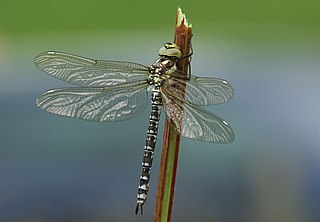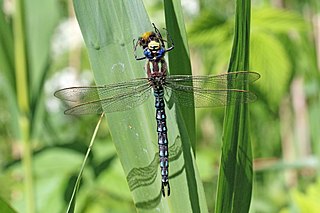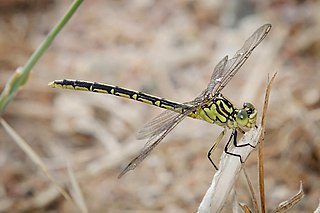
Aeshna isoceles is a small hawker dragonfly that is found in Europe, mostly around the Mediterranean, and the lowlands of North Africa. Its common name in English is green-eyed hawker. In Britain it is a rare and local species and is known as the Norfolk hawker. It has a brown colour with green eyes and clear wings and also a yellow triangular mark on the second abdominal segment which gave rise to its scientific name. It used to be in the genus Anaciaeschna as it has several differences from the other members of the genus Aeshna. Its specific name is often spelt isosceles.

The Aeshnidae, also called aeshnids, hawkers, or darners, is a family of dragonflies. The family includes the largest dragonflies found in North America and Europe and among the largest dragonflies on the planet.

Aeshna, or the mosaic darners, is a genus of dragonflies from the family Aeshnidae. Species within this genus are generally known as "hawkers" or "darners".

The emperor dragonfly or blue emperor is a large species of hawker dragonfly of the family Aeshnidae, averaging 78 millimetres (3.1 in) in length. The generic name Anax is from the ancient Greek ἄναξ, "lord"; the specific epithet imperator is the Latin for "emperor", from imperare, to command.

The southern hawker or blue hawker is a species of hawker dragonfly.

The azure hawker is one of the smaller species of hawker dragonflies,. The flight period is from late May to August

Brachytron is a monotypic genus of European dragonfly of the family Aeshnidae containing the hairy dragonfly, also known as the hairy hawker or spring hawker.

Anax guttatus, the pale-spotted emperor or lesser green emperor, is a dragonfly of the family Aeshnidae.

Adversaeschna is a monotypic genus of large dragonflies in the family Aeshnidae. Adversaeschna brevistyla is the only known species of this genus which is found in Australia, New Zealand, Norfolk Island and some Pacific Islands.

The blue riverdamsel, Pseudagrion microcephalum is a common species of damselfly in the family Coenagrionidae. It is also known as the blue sprite and blue grass dart.

Aeshna affinis, the southern migrant hawker or blue-eyed hawker, is a dragonfly found in southern Europe and Asia. It is in the family Aeshnidae and is very similar in appearance to A. mixta.

The Australian emperor dragonfly, also known as the yellow emperor dragonfly, scientific name Anax papuensis, is a species of dragonfly in the Aeshnidae family. It is black with yellow dots along its tail.

Diplacodes trivialis is a species of dragonfly in the family Libellulidae known as the chalky percher or ground skimmer. It is found in China, Japan, India and southwards to New Guinea and Australia.

The Australian emerald is a species of dragonfly in the family Corduliidae. It can be found in Australia, Lord Howe Island, Norfolk Island, Lesser Sunda Islands and New Zealand. It is a small to medium-sized, long-legged dragonfly coloured black-metallic and yellow. In both males and females the inboard edge of the hindwing is rounded.

Potamarcha congener is a species of dragonfly in the family Libellulidae. It was first described by Jules Pierre Rambur in 1842, almost fifty years before Friedrich Karsch described its genus. Potamarcha congener is one of two species making up the genus Potamarcha, together with Potamarcha puella.

Agriocnemis pygmaea is a species of damselfly in the family Coenagrionidae. It is also known as wandering midget, pygmy dartlet or wandering wisp. It is well distributed across Asia and parts of Australia.

Zyxomma petiolatum, known by the common names long-tailed duskdarter, brown dusk hawk and dingy duskflyer, is a species of dragonfly in the family Libellulidae. It is widespread in many Asian countries, New Guinea, northern Australia and islands in the Pacific.

Procordulia jacksoniensis is a species of dragonfly in the family Corduliidae, known as the eastern swamp emerald. It inhabits rivers, pools and lakes in eastern Australia, from Brisbane through New South Wales, Victoria and Tasmania, and around Adelaide in South Australia.

Anax gibbosulus is a species of large dragonfly of the family Aeshnidae, commonly known as the green emperor. It inhabits swamps and brackish waters from India through northern Australia to the Pacific.

Austrogomphus guerini, also known as Austrogomphus (Austrogomphus) guerini, is a species of dragonfly of the family Gomphidae, commonly known as the yellow-striped hunter. It inhabits streams, rivers and lakes in eastern New South Wales, Victoria and Tasmania, Australia.
































